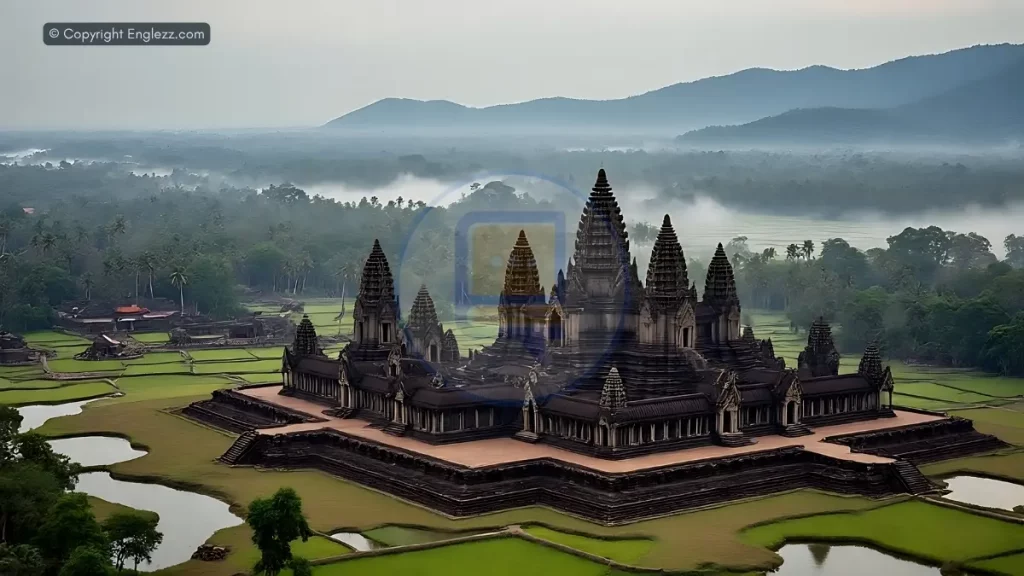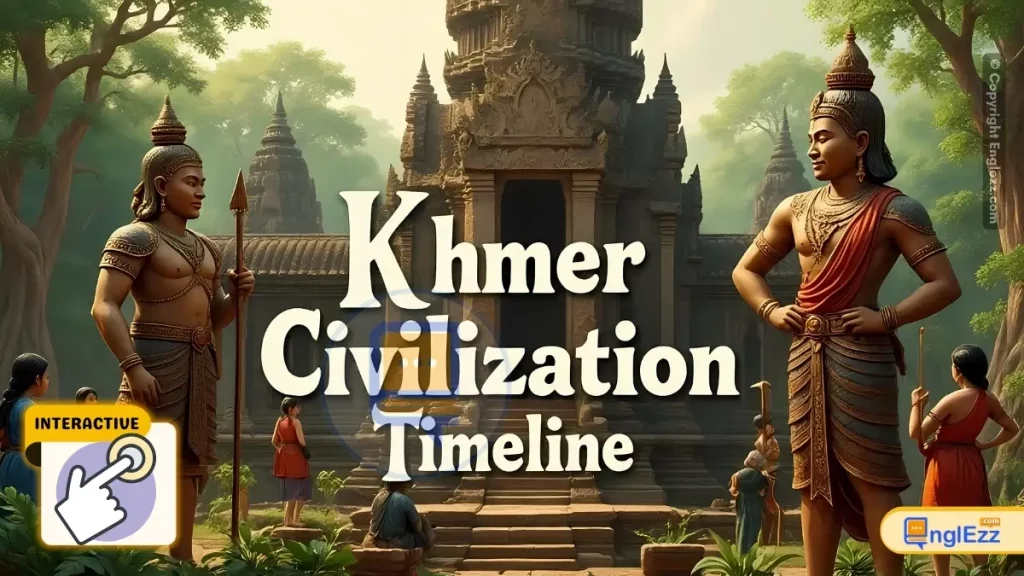
The Story of the Khmer Empire
Angkor Wat Builders (802-1431 CE)
Introduction
The Khmer Empire Journey
The Khmer Empire was one of the most powerful and influential civilizations in Southeast Asian history, dominating much of the region from the 9th to 15th centuries. Centered in what is now Cambodia, the empire created the magnificent temple complex of Angkor Wat, the largest religious monument in the world.
The Khmer excelled at hydraulic engineering, architecture, art, and administration. Their sophisticated water management systems supported intensive rice cultivation that sustained a large population. The empire’s architectural achievements, particularly the Angkor temple complex, showcase their advanced engineering skills and Hindu-Buddhist cosmology.
Early Period
The Early period (802-1219 CE) saw the foundation of the Khmer Empire under Jayavarman II and the establishment of Angkor as its capital. During this time, the empire expanded its territory and developed its distinctive architectural style, blending Hindu and indigenous Khmer elements.
Classic Period
The Classic period (1219-1431 CE) was the golden age of the Khmer Empire, marked by the construction of Angkor Wat under Suryavarman II and Angkor Thom under Jayavarman VII. The empire reached its greatest territorial extent and cultural achievements during this time.
Modern Rediscovery
After centuries of being reclaimed by the jungle, Angkor was rediscovered by Western explorers in the 19th century. Modern archaeology has revealed the sophistication of Khmer engineering and urban planning. Today, Angkor Wat remains a symbol of Cambodian national identity.
Interactive Khmer Empire Timeline
Foundation of the Khmer Empire
Jayavarman II declares himself chakravartin (universal monarch), marking the beginning of the Khmer Empire.
Read moreJayavarman II (reigned c. 802-835 CE) is traditionally regarded as the founder of the Khmer Empire. He established his capital at Mahendraparvata (modern Phnom Kulen) and performed a sacred ritual to declare independence from Javanese influence, establishing the cult of the devaraja (god-king).
Key developments during Jayavarman II’s reign:
- Unification of smaller Khmer states into a single empire
- Establishment of the devaraja cult linking the king to Shiva
- Creation of a centralized administration
- Early temple construction in the Phnom Kulen style
This period marked the transition from the pre-Angkorian to the Angkorian period in Cambodian history, setting the stage for the empire’s future greatness.
Further Reading
- Higham, Charles. The Civilization of Angkor (2001)
- Jacques, Claude. Angkor: Cities and Temples (1997)
Yasovarman I Moves Capital to Angkor
Yasovarman I establishes the capital at Yasodharapura (Angkor), beginning the Angkor period.
Read moreYasovarman I (reigned 889-910 CE) moved the capital from Hariharalaya to the area now known as Angkor, where it would remain for most of the empire’s history. He named his new capital Yasodharapura and built the first major temple at the site, Phnom Bakheng.
Key achievements of Yasovarman I:
- Established the Angkor region as the empire’s political and religious center
- Built the East Baray, a massive reservoir measuring 7.5 by 1.8 km
- Developed an urban plan that would influence later Khmer cities
- Constructed numerous ashramas (hermitages) throughout the empire
Yasovarman’s reign marked the beginning of Angkor’s golden age and established the pattern of successive kings building their own state temples.
Further Reading
- Mabbett, Ian, and David Chandler. The Khmers (1995)
- Rooney, Dawn. Angkor: Cambodia’s Wondrous Khmer Temples (2011)
Suryavarman II Begins Angkor Wat
Suryavarman II ascends to the throne and begins construction of Angkor Wat.
Read moreSuryavarman II (reigned 1113-c.1150 CE) was one of the Khmer Empire’s greatest kings. He expanded the empire’s territory and initiated construction of Angkor Wat, the largest religious monument in the world, dedicated to the Hindu god Vishnu.
Key features of Angkor Wat:
- Covers over 400 acres (1.6 km²), with a moat 190 meters wide
- Represents Mount Meru, home of the Hindu gods
- Features extensive bas-reliefs depicting Hindu epics and Khmer history
- Oriented to the west, possibly for funerary purposes
Suryavarman II’s reign marked the peak of Khmer power and artistic achievement. The temple’s construction required an estimated 300,000 workers and 6,000 elephants, demonstrating the empire’s wealth and organizational capacity.
Further Reading
- Freeman, Michael, and Claude Jacques. Ancient Angkor (2003)
- Mannikka, Eleanor. Angkor Wat: Time, Space, and Kingship (1996)
Jayavarman VII Ascends the Throne
Jayavarman VII becomes king and transforms the empire into a Buddhist state.
Read moreJayavarman VII (reigned 1181-1219 CE) was the Khmer Empire’s most prolific builder and the first Buddhist king. After repelling a Cham invasion, he constructed Angkor Thom as his new capital and the Bayon as its central temple.
Major achievements of Jayavarman VII:
- Built Angkor Thom with its famous Bayon temple featuring stone faces
- Constructed an extensive network of roads, hospitals, and rest houses
- Established Mahayana Buddhism as the state religion
- Expanded the empire to its greatest territorial extent
Jayavarman VII’s reign represented both the zenith of Khmer power and the beginning of its decline, as his massive building projects may have overtaxed the empire’s resources.
Further Reading
- Coedès, George. The Indianized States of Southeast Asia (1968)
- Higham, Charles. Early Cultures of Mainland Southeast Asia (2002)
Abandonment of Angkor
The Khmer abandon Angkor as their capital after a Siamese attack, moving to Phnom Penh.
Read moreIn 1431, the Siamese Ayutthaya Kingdom sacked Angkor, leading the Khmer to abandon it as their capital. The exact reasons for Angkor’s decline are complex and likely include:
- Environmental degradation from deforestation and water management failures
- Economic strain from maintaining the extensive temple network
- Shifts in trade routes that reduced Angkor’s economic importance
- Repeated invasions from neighboring states
- The growing influence of Theravada Buddhism, which required less monumental architecture
While the Khmer state continued, it never regained its former power. The jungle gradually reclaimed Angkor’s temples, preserving them for later rediscovery.
Further Reading
- Chandler, David. A History of Cambodia (2008)
- Penny, Dan, et al. “The Demise of Angkor” (2007)
Rediscovery of Angkor Wat
French naturalist Henri Mouhot “discovers” Angkor Wat for the Western world.
While never completely forgotten by locals, Angkor Wat was brought to Western attention by French explorer Henri Mouhot, who visited in 1860 and published vivid descriptions of the ruins. His accounts sparked international interest in Khmer archaeology.
Key developments in Angkor’s modern history:
- 1863 – Cambodia becomes a French protectorate
- 1907 – Angkor region returned to Cambodia from Siam
- 1908-1953 – École française d’Extrême-Orient conducts major restoration work
- 1992 – Angkor declared a UNESCO World Heritage Site
Today, Angkor Wat is Cambodia’s most visited tourist attraction and appears on the national flag, symbolizing the country’s cultural heritage.
Further Reading
- Mouhot, Henri. Travels in Siam, Cambodia and Laos (1864)
- Falser, Michael. Cultural Heritage as Civilizing Mission (2015)
Angkor Named UNESCO World Heritage Site
UNESCO designates Angkor as a World Heritage Site, recognizing its cultural significance.
Read moreIn 1992, UNESCO added Angkor to its World Heritage List, acknowledging it as “one of the most important archaeological sites in Southeast Asia.” The designation helped mobilize international resources for conservation efforts.
Key conservation challenges at Angkor:
- Damage from centuries of neglect and vegetation growth
- Effects of mass tourism on fragile structures
- Illegal looting of artifacts
- Environmental pressures from nearby development
The UNESCO designation has helped balance preservation with sustainable tourism, ensuring that Angkor remains accessible while protecting its structures for future generations.
Further Reading
- Miura, Keiko. World Heritage Angkor and Beyond (2011)
- UNESCO. Angkor World Heritage Site Documentation (1992)
Khmer Empire Quiz
Test Your Knowledge of Khmer History
Frequently Asked Questions
Common Questions About the Khmer Empire
The decline of the Khmer Empire was likely caused by multiple interconnected factors:
- Environmental factors: The complex water management system may have failed due to deforestation and siltation
- Economic strain: Maintaining the extensive temple network and bureaucracy became unsustainable
- External pressures: Repeated invasions from the Siamese Ayutthaya Kingdom weakened the empire
- Religious changes: The shift to Theravada Buddhism required fewer resources than Hindu temple-building
- Trade shifts: Maritime trade routes became more important than overland routes controlled by Angkor
By the 15th century, the capital had moved to Phnom Penh, and Angkor was gradually abandoned to the jungle.
Angkor Wat’s construction was an enormous undertaking that demonstrated the Khmer Empire’s advanced engineering and organizational skills:
- Materials: Built primarily with sandstone (5-10 million blocks) quarried from Mount Kulen
- Labor: Estimated 300,000 workers and 6,000 elephants were employed
- Transport: Stones were floated down the Siem Reap River on rafts
- Engineering: Sophisticated water management system prevented flooding
- Time: Construction took approximately 30 years (1113-1145 CE)
The temple’s precise alignment with celestial events and its elaborate bas-reliefs demonstrate the Khmer’s knowledge of astronomy and artistic skill.
The Khmer Empire made numerous significant advances, including:
- Architecture: Built Angkor Wat, the largest religious monument in the world
- Engineering: Created an extensive water management system with canals and reservoirs
- Urban planning: Developed one of the largest pre-industrial cities in the world
- Art: Produced exquisite stone carvings and bas-reliefs
- Administration: Established a complex bureaucracy to govern a vast empire
- Agriculture: Supported a large population through intensive rice cultivation
These achievements made the Khmer Empire one of Southeast Asia’s most powerful and sophisticated civilizations.
Yes, Angkor Wat remains an active religious site:
- Originally Hindu, it gradually became a Buddhist temple by the end of the 12th century
- Today it serves as an important site for Theravada Buddhist worship
- Monks continue to live and pray at the temple complex
- Religious ceremonies and festivals are regularly held at the site
- Pilgrims from across Cambodia and Southeast Asia visit for spiritual purposes
While also a major tourist attraction, Angkor Wat maintains its sacred character and is treated with reverence by Cambodians.
Conclusion
The Khmer Legacy
The Khmer Empire represents one of Southeast Asia’s most remarkable civilizations, leaving behind an architectural and artistic legacy that continues to inspire awe. From its founding in 802 CE to its decline in the 15th century, the empire demonstrated extraordinary achievements in engineering, urban planning, and statecraft.
While the empire eventually faded, its cultural influence remains strong in modern Cambodia. Angkor Wat stands as a powerful symbol of national identity and a testament to human creativity and perseverance.
Khmer Empire Key Takeaways
Early Foundations
The Early period established the Khmer Empire’s political and religious foundations, with Jayavarman II creating the devaraja cult and Yasovarman I moving the capital to Angkor.
Classic Achievements
The Classic period saw the construction of Angkor Wat and Angkor Thom, representing the height of Khmer architectural and artistic achievement.
Decline and Transformation
After the 15th century, the Khmer state transformed, moving its capital and adopting Theravada Buddhism while maintaining cultural continuity.
Modern Rediscovery
Angkor’s rediscovery and preservation efforts have made it one of the world’s most important archaeological sites and a symbol of Cambodian heritage.
The study of the Khmer Empire reminds us of the incredible cultural achievements possible when human ingenuity is combined with strong leadership and vision. As we continue to uncover the secrets of Angkor, we gain not only historical knowledge but also inspiration from this remarkable civilization’s ability to shape its environment and create enduring monuments to its beliefs.
Recommended Reading About the Khmer Empire
- Higham, Charles. The Civilization of Angkor (2001)
- Jacques, Claude. Angkor: Cities and Temples (1997)
- Chandler, David. A History of Cambodia (2008)
- Freeman, Michael, and Claude Jacques. Ancient Angkor (2003)
- Mabbett, Ian, and David Chandler. The Khmers (1995)










Khmer Empire Timeline Map: Uncover the rich history from Angkor Wat to modern Cambodia with our interactive map that brings the past to life!